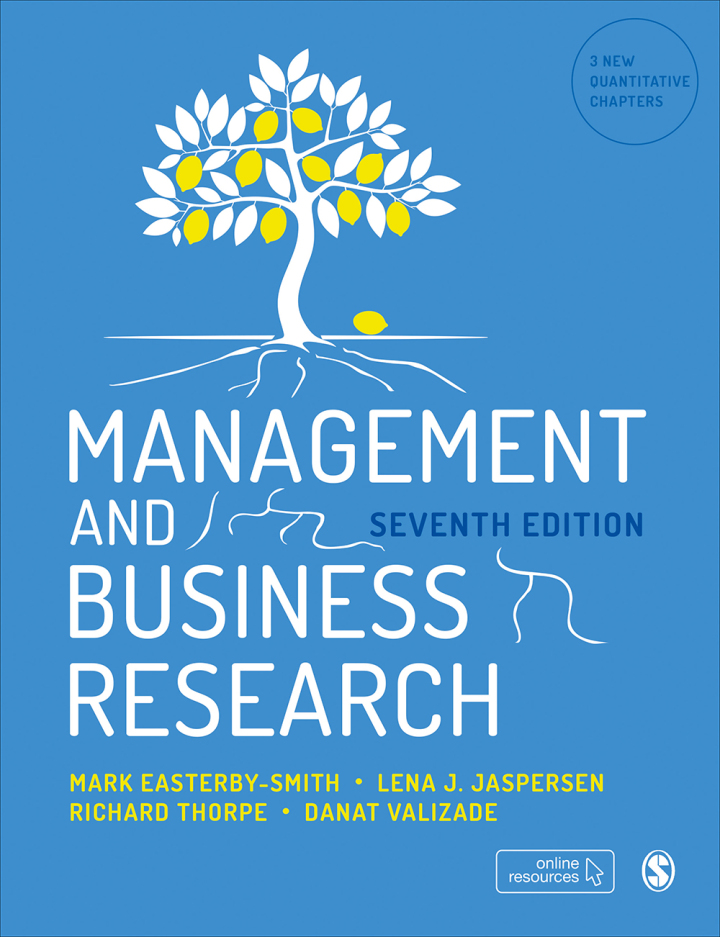
Management and Business Research 7th Edition
PUBLISHER: Sage
Trường ĐH, Nhóm, Thư Viện: Gọi 0915920514 để báo giá eBook hosting trên Vital Source hoặc mua Sách In
Nghiên cứu quản lý và kinh doanhCuốn sách giáo khoa bán chạy nhất này đã được cập nhật đầy đủ và cung cấp cho người đọc cái nhìn tổng quan toàn diện về các phương pháp tiến hành nghiên cứu kinh doanh và quản lý. Có tính trực quan cao và được viết theo cách rõ ràng và dễ tiếp cận, cuốn sách bao gồm các tính năng học tập hữu ích xuyên suốt, bao gồm mục tiêu học tập ở đầu mỗi chương, tính năng nghiên cứu hành động, ví dụ, mẫu Canvas Kế hoạch nghiên cứu, v.v. Nội dung đã được cập nhật với việc bao gồm dữ liệu lớn, phân tích dự đoán và một chương dành riêng về học máy. Đi kèm cuốn sách là vô số tài nguyên trực tuyến để nâng cao hơn nữa trải nghiệm học tập của bạn, bao gồm: MCQ Nội dung video Mẫu và bộ dữ liệu Bảng chú giải thuật ngữ Các nghiên cứu điển hình bổ sung Sinh viên có thể truy cập những nội dung này tại Study.sagepub.com/easterbysmith7e
About the AuthorsPreface to the Seventh EditionAcknowledgementsPraise for the BookGuide to IconsOnline ResourcesYour Guide to the Research Process1 Finding Your Feet in Management and Business ResearchIntroductionThe landscape of management and business researchFeatures of a research projectWriting a research proposalStructure of the bookConclusionFurther reading2 Reviewing the LiteratureIntroductionWhat is a literature review and what are its main purposes?Types of literature reviewsChoosing a research problemPreparing a literature review: finding and recording relevant literatureFinding relevant literatureEvaluating literatureWriting a literature reviewConclusionFurther reading3 The Philosophy of Management and Business ResearchIntroductionThe tree as a metaphor for the research processThe philosophical debatesStrengths and weaknesses of the main paradigmsMixing approaches and methodsParadigms and research approachesMapping philosophies and approachesConclusionFurther reading4 Designing Management and Business ResearchIntroductionTypes of research designPositivist research designsConstructionist research designsCase study research and Grounded TheoryMixed methodsCommon design dilemmasContributing to theoryContrasting views on validity and reliabilityResearch design templateConclusionFurther reading5 The Ethical ResearcherIntroductionPolitics and power in researchAccess and engagementEthicsAcademiaMindset and attitudeConclusionFurther reading6 Crafting Qualitative Data through Language and TextIntroductionCrafting qualitative dataSecondary textual dataPrimary textual dataQualitative interviewsPreparing for data collectionConducting interviewsGroup interviews and focus groupsInterview-based mapping techniquesConclusionFurther reading7 Crafting Qualitative Data through Observation and Participatory ResearchIntroductionVisual dataObservational researchInteractive and participatory methodsTriangulationPositionality and reflexivityConclusionFurther reading8 Framing and Interpreting Qualitative DataIntroductionPreparing and managing qualitative dataChoosing a method for the analysis of qualitative dataFraming and interpreting qualitative data: eight approachesComputer-aided analysisQuality in qualitative researchConclusionFurther reading9 Crafting Quantitative DataIntroductionExperimental and observational quantitative studiesSources of primary dataUsing secondary data sourcesWorking with data: data pre-processing and measurementsConclusionFurther reading10 Statistical Analysis of Quantitative DataIntroductionDescribing and visualizing dataGoing beyond a sample: statistical hypothesis testingCausal modelling: regression analysisConclusionFurther reading11 Application of Machine Learning in Quantitative ResearchIntroductionMachine learning in business and management researchTypes of machine learningUnsupervised learningSupervised learningInterpretable machine learning: What is inside a black box?ConclusionFurther reading12 Writing Management and Business ResearchIntroductionAudiences and outputsWriting with skillIntroductionsLiterature reviewsFrom methods to conclusionsPlagiarismDissemination strategiesConclusionFurther readingGlossaryBibliographyIndex















